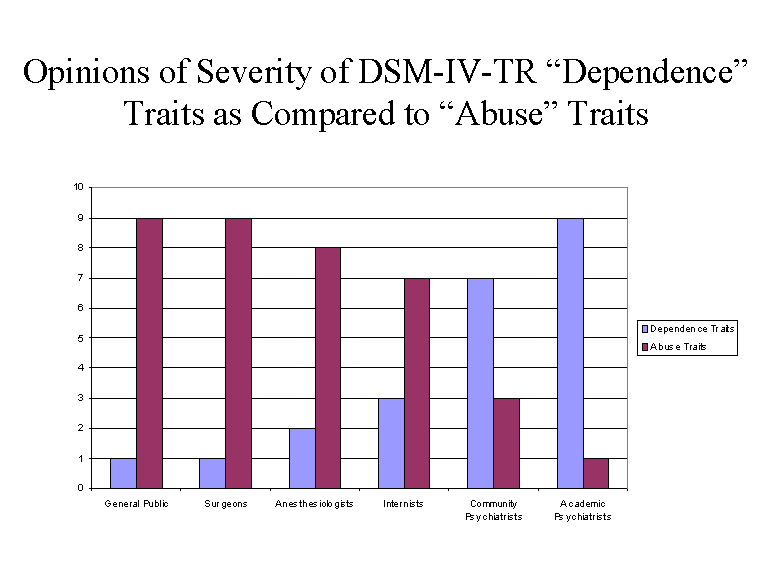
When Nomenclature is Harmful:
Evidence Supporting the Use of the Word, “Addiction?Instead of
“Dependence?in the Nomenclature of Substance Use Disorders
By John T. Tennison, MD, Copyright 2001, All rights reserved.
Abstract
This article is based on survey data that I collected from sixty individuals. Fifty were physicians, while the remaining ten were non-physicians who did not work in a health-related field. The data were first presented at the October, 2001 meeting of the Academy of Psychiatry and the Law in Boston, MA. In general, the survey results reveal how usage of the word, “dependence?is fraught with multiple problems. Moreover, the data recall the moment in DSM (Diagnostic and Statistical Manual) history when framers of the DSM-III were deciding whether to use the word, “dependence?or “addiction?to describe the syndrome that DSM-IV-TR now calls “dependence. It was at this historical meeting that the word “addiction?lost by only one vote to the word, “dependence?for usage in the DSM-III. Charles P. O’Brien, M.D., Ph.D., of the University of Pennsylvania, confirms that the actual vote was seven in favor of “dependence,?and six in favor of “addiction. Dr. O’Brien, one of the nation’s foremost addiction experts, prefers the word, “addiction?to the word “dependence,?and was one of the six individuals who voted for the word, “addiction?over “dependence?during the formation of the DSM-III. I conclude from my data that, overall, less harm would result if we use the word, “addiction,?for the syndrome that the DSM-IV-TR now calls, “dependence. While not everyone agrees with this conclusion, my survey data strongly suggest the need to re-open this debate.
Background
Expert Opinion by Charles P. O’Brien:
(from
Goodman & Gilman’s The Pharmacological
Basis of Therapeutics, 10th Edition, 2001, page 621.)
“Abuse
and addiction have been defined and redefined by several organizations over the
past 25 years. The reason for these
revisions and disagreements is that abuse and addiction are behavioral syndromes
that exist along a continuum from minimal use to abuse to addictive use.
While tolerance and physical dependence are biological phenomena that can
be defined precisely in the laboratory and diagnosed accurately in the clinic,
there is an arbitrary aspect to the definitions of the overall behavioral
syndromes of abuse and addiction. The
most influential system of diagnosis for mental disorders is that published by
the American Psychiatric Association (DSM IV, 1994).
The APA diagnostic system uses the term substance dependence instead
addiction for the overall behavioral syndrome.
Although widely accepted, this terminology can lead to confusion between
physical dependence and psychological dependence.
The term addiction, when used in this chapter, will refer to compulsive
drug use, the entire substance dependence syndrome as defined in DSM IV.
This should not be confused with physical dependence alone, a common
error among physicians. Addiction is not used as a pejorative term;
in fact, the journal Addiction is one of the oldest scientific journals
in this therapeutic area.?o:p>
Expert Opinion by Jerome H. Jaffe:
(from Goodman & Gilman’s The Pharmacological Basis of
Therapeutics, 7th Edition, 1985.)
“The
use of the terms drug dependence, to denote a behavioral syndrome, and
physiological dependence, to refer to biological changes that underlie
withdrawal syndromes, causes confusion.?o:p>
Expert Opinion by Russell K. Portenoy and Richard Payne:
(from Substance Abuse: A
Comprehensive Textbook, 3rd Edition, 1997.)
“Use
of the term ‘addiction?to describe patients who are merely physically
dependent reinforces the stigma associated with opioid therapy and should be
abandoned. If the clinician wishes
to describe a patient who is believed to have the capacity for abstinence, the
term ‘physical dependence?must be used.?o:p>
“Labeling
the patient as ‘dependent?also should be discouraged, since it fosters
confusion between ‘physical dependence?and ‘psychological dependence.
The latter is an accepted component of the ‘addiction syndrome?(as
described later in this chapter) and is unrelated to the occurrence of
‘physical dependence.’”
Research Methods
Six questions
were asked to a total of 60 individuals. Twenty
of these were psychiatrists by training. Of
these twenty, ten were academic psychiatrists, while the remaining ten were
community psychiatrists.
All twenty psychiatric subjects were chosen by random selection from the
Show Room Floor of the New Orleans Convention Center at the 2001 Annual meeting
of the American Psychiatric Association. The
Ten subjects who described themselves as “academic psychiatrists,?were
full-time faculty at an academic institution with a minimal rank of at least
assistant professor. The remaining
ten psychiatrists did not have any academic or teaching affiliation, but instead
were either in private practice or in the public psychiatry sector.
The next ten subjects were drawn from the general public and were
verified to not be working in a health-related field.
These ten subjects were chosen by random selection from the parking lot
of a large Super Market in San Antonio, TX, in May of 2001.
The remaining thirty subjects were chosen by random selection at meetings
of the Bexar County Medical Society in San Antonio, TX. Of these thirty, ten were anesthesiologists, ten were
internists, and the final ten were general surgeons.
Of these last thirty subjects, no determination was made as to their
academic affiliations.
Construction of the Survey Questions
The questions were designed to test several hypotheses that I had
regarding confusion surrounding nomenclature used in DSM-IV-TR
for substance-related disorders.
The survey had a total of six questions.
The
first question simply asked the reader to compare two lists, and to choose the
list that seemed to be describing “a more severe set of circumstances related
to substance use.
The first list was a verbatim transcription of the “substance
dependence?criteria from DSM-IV-TR.
The second list was a verbatim transcription of the “substance abuse?
criteria from DSM-IV-TR.
This question was designed to test the hypothesis that overall, the
“abuse?criteria appear to be more severe than the “dependence?
criteria. Although
most academically-trained psychiatrists will say that “substance dependence?
is intended to be a more severe diagnosis, my hypothesis was that this idea was
poorly communicated to those who were relying solely on the criteria sets in the
DSM-IV-TR.
The
second question was constructed to see how the responder would react to a
patient in need of pain treatment, but who carries a diagnosis of “substance
dependence.
Here, the hypothesis was that the label of “substance-dependent?
could result in inadequate treatment of the patient’s pain.
The
third question was constructed to test the subject’s knowledge of DSM-IV-TR’s
criteria for “substance dependence.
The hypothesis was that, because of the pharmacological meaning of the
word, “dependence,?subjects would be confused and mistakenly believe that
tolerance and/or withdrawal were required to meet DSM-IV-TR criteria for
“substance dependence.?o:p>
The
fourth question was constructed to see what word would be preferred for five of
the seven traits in the syndrome that DSM-IV-TR uses for “substance
dependence.
“Tolerance?and “Withdrawel?were not included in this list
because the hypothesis of this question was that leaving out the traits of
“tolerance?and “withdrawel?would cause responders to prefer
“addiction?as a term to describe the syndrome, rather than the word,
“dependence.?o:p>
The
fifth question was constructed to see what word would be preferred to describe a
syndrome consisting only of “tolerance?and “withdrawal.
The hypothesis here was that most responders would prefer
“dependence,?as this word is consistent with the traditional
pharmacological definition of the word, rather than the highly idiosyncratic use
of “dependence?found in the DSM-IV-TR.
The sixth question was constructed to see what word would be preferred for the four criteria that DSM-IV-TR uses in its definition of “substance abuse. The hypothesis here was that subjects would prefer “abuse?or “addiction?to “dependence?as a word to describe this syndrome.
The Exact Wording of the Six Questions Used in the Survey
1.) Which of the following two lists (List 1 or List 2) describes
a more severe set of circumstances related to substance use?
1.
A need
for markedly increased amounts of the substance to achieve intoxication or
desired effect and/or markedly diminished effect with continued use of the same
amount of the substance.
2.
Presence
of the characteristic withdrawal syndrome for the substance and/or the same (or
a closely related) substance is taken to relieve or avoid withdrawal symptoms.
3.
The
substance is often taken in larger amounts or over a longer period than was
intended.
4.
There is
a persistent desire or unsuccessful efforts to cut down or control substance
use.
5.
A great
deal of time is spent in activities necessary to obtain the substance (e.g.,
visiting multiple doctors or driving long distances), use the substance (e.g.,
chain-smoking), or recover from its effects.
6.
Important
social, occupational, or recreational activities are given up or reduced because
of substance use.
7.
The
substance use is continued despite knowledge of having a persistent or recurrent
physical or psychological problem that is likely to have been caused or
exacerbated by the substance (e.g., current cocaine use despite recognition of
cocaine-induced depression, or continued drinking despite recognition that an
ulcer was made worse by alcohol consumption).
1.
Recurrent
substance use resulting in a failure to fulfill major role obligations at work,
school, or home (e.g., repeated absences or poor work performance related to
substance use; substance-related absences, suspensions, or expulsions from
school; neglect of children or household)
2.
Recurrent
substance use in situations in which it is physically hazardous (e.g., driving
an automobile or operating a machine when impaired by substance use)
3.
Recurrent
substance-related legal problems (e.g., arrests for substance-related disorderly
conduct)
4.
Continued
substance use despite having persistent or recurrent social or interpersonal
problems caused or exacerbated by the effects of the substance (e.g., arguments
with spouse about consequences of intoxication, physical fights)
Indicate
your choice by circling A or B below:
A. List
1
B.
List 2
2.) A patient with known opioid substance dependence disorder is
in an automobile accident, resulting in several bone fractures.
While in the hospital, the patient demands opioid pain medication in
significantly greater amounts than would normally be used to treat pain from
injuries similar to the patient’s. All
available non-opioid medications have been tried, but the patient insists that
these have not worked. Which of the
following would be your choice as a response to the patient’s request?
(Please mark the answer than you would actually pursue, rather than what
you perceive to be the “idea,?“right,?or “best?answer.)
A.
Titrate the patient’s opioid medication upward while monitoring the
patient’s vital signs and until the patient’s complaints of pain cease.
B.
Consult the pain-management service
C.
Try opioid medication, but given the patient’s opioid dependence
disorder, administer no more opioid medication than would be expected to relieve
pain in a person who was not addicted to opioids.
D.
Try opioid medication, but given the patient’s opioid dependence
disorder, limit the overall opioid medication to less than what you would
administer to a patient who did not have opioid dependence disorder.
E.
None of the above
3.)
Which of the following must be present to meet DSM-IV-TR criteria for
substance dependence disorder?
A. Important social, occupational, or recreational activities
are given up or reduced because of substance use.
B. The substance use is continued despite knowledge of having a
persistent or recurrent physical or psychological problem that is likely to have
been caused or exacerbated by the substance (e.g., current cocaine use despite
recognition of cocaine-induced depression, or continued drinking despite
recognition that an ulcer was made worse by alcohol consumption).
C. Presence of either tolerance (increased amounts of a
substance to achieve the same effect) or withdrawal symptoms.
D. None of the above
4.)
Please consider the following list of 5 traits related to substance u
1. The substance is often taken in larger amounts or over a
longer period than was intended
2. There is a persistent desire or unsuccessful efforts to cut
down or control substance use.
3. A great deal of time is spend in activities necessary to
obtain the substance (e.g., visiting multiple doctors or driving long
distances), use the substance (e.g., chain-smoking), or recover from its effects
4. Important social, occupational, or recreational activities
are given up or reduced because of substance use.
5. The substance use is continued despite knowledge of having a
persistent or recurrent physical or psychological problem that is likely to have
been caused or exacerbated by the substance (e.g., current cocaine use despite
recognition of cocaine-induced depression, or continued drinking despite
recognition that an ulcer was made worse by alcohol consumption).
Presence
of the 5 traits above is best described by which of the following words?
(Choose only 1 answer.)
A. Abuse
B.
Addiction
C.
Dependence
D.
Impairment
E.
None of the above
5.)
Please consider the following list of 2 traits related to substance use:
1.
A need for markedly increased amounts of the substance to achieve
intoxication or desired effect and/or markedly diminished effect with continued
use of the same amount of the substance
2.
Presence of the characteristic withdrawal syndrome for the substance
and/or the same (or a closely related) substance is taken to relieve or avoid
withdrawal symptoms
Presence
of the 2 traits above is best described by which of the following words?
(Choose only 1 answer.)
A. Abuse
B.
Addiction
C.
Dependence
D.
Impairment
E.
None of the above
6.) Please consider the following list of 4 traits related to substance use:
1.
Recurrent substance use resulting
in a failure to fulfill major role obligations at work, school, or home (e.g.,
repeated absences or poor work performance related to substance use;
substance-related absences, suspensions, or expulsions from school; neglect of
children or household)
2.
Recurrent substance use in
situations in which it is physically hazardous (e.g., driving an automobile or
operating a machine when impaired by substance use)
3.
Recurrent substance-related legal problems (e.g.,
arrests for substance-related disorderly conduct)
4.
Continued substance use despite having persistent or
recurrent social or interpersonal problems caused or exacerbated by the effects
of the substance (e.g., arguments with spouse about consequences of
intoxication, physical fights)
Presence
of the 4 traits above is best described by which of the following words?
(Choose only 1 answer.)
A.
Abuse
B.
Addiction
C.
Dependence
D.
Impairment
E. None of the above
Results of Question #1

Results of Question #2
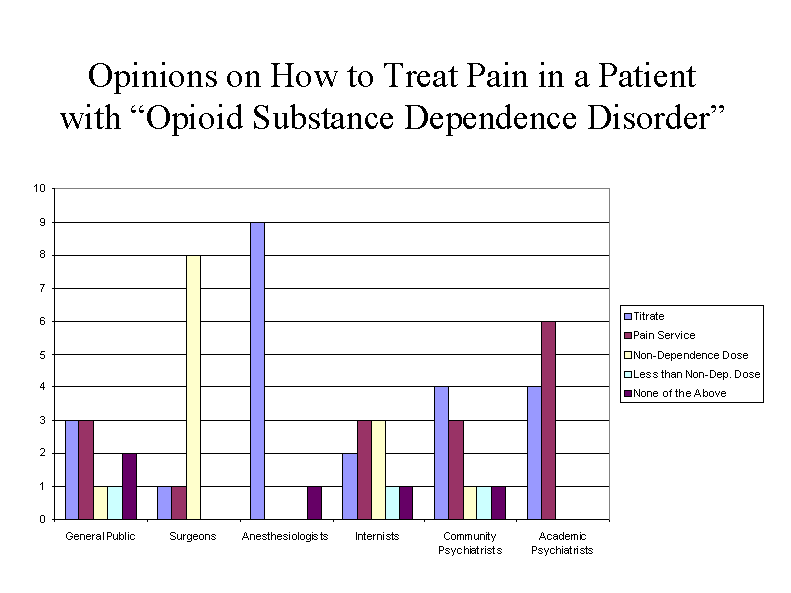
Results of Question #3
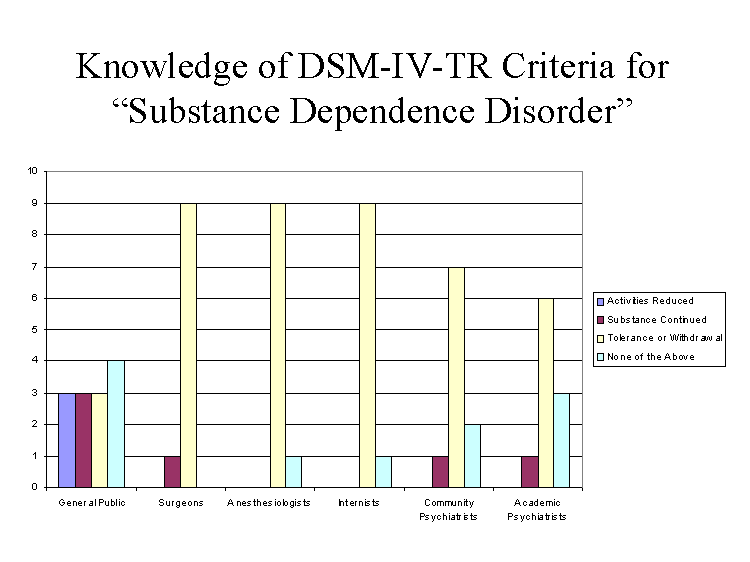
Results of Question #4
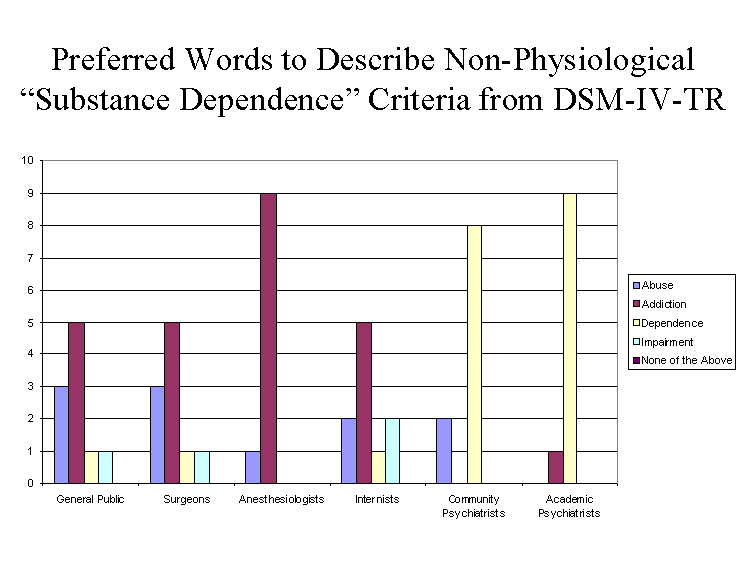
Results of Question #5
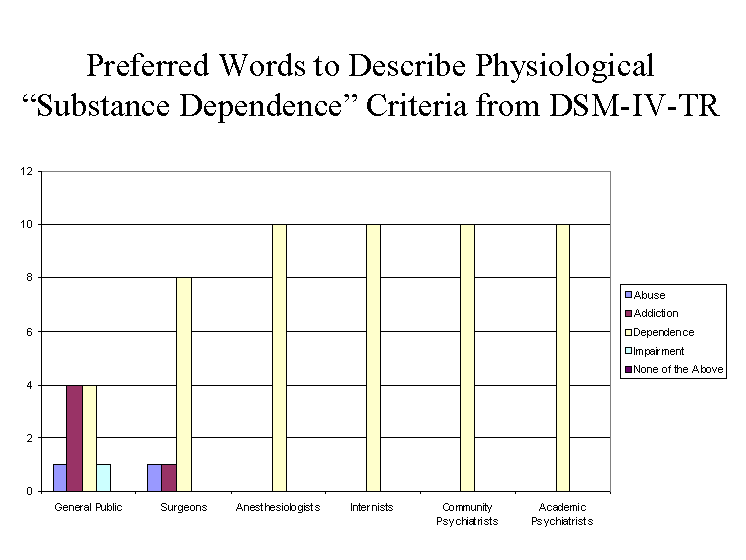
Results of Question #6
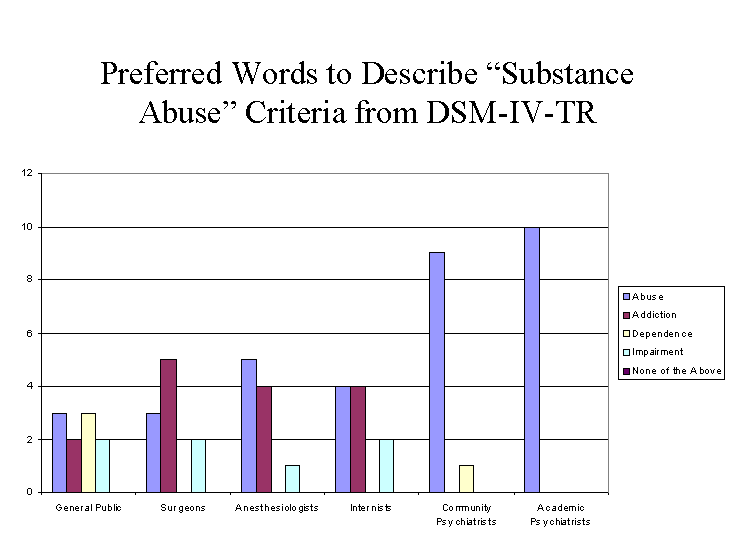
Discussion and Conclusions
In
general, the survey results reveal how usage of the word, “dependence?is
fraught with multiple problems. Moreover,
the data recall the moment in DSM history when framers of DSM III were deciding
whether to use the word, “dependence?or “addiction?to describe the
syndrome that DSM-IV-TR now calls “dependence.
It was at this historical meeting that the word “addiction?lost by
only one vote to the word, “dependence?for usage in the DSM III.
Charles P. O’Brien, M.D., Ph.D., of the University of Pennsylvania,
confirms that the actual vote was seven in favor of “dependence,?and six in
favor of “addiction. Dr.
O’Brien, one of the nation’s foremost addiction experts, prefers the word,
“addiction?to the word “dependence,?and was one of the six individuals
who voted for the word, “addiction?over “dependence?during the
formation of the DSM-III.
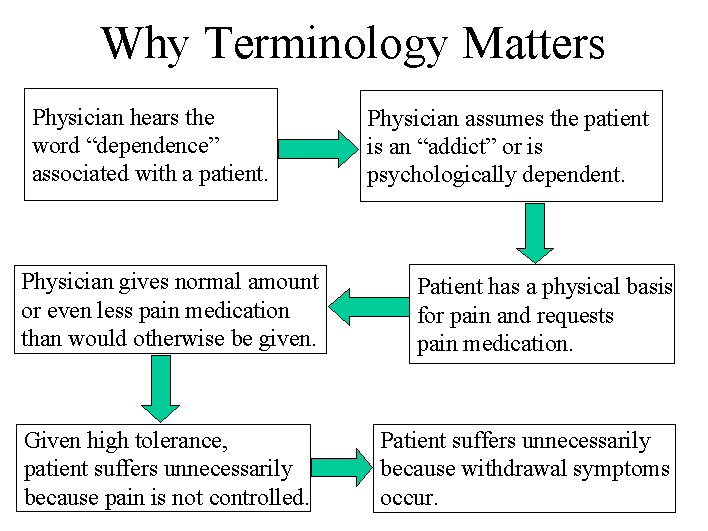
Using
the Term, “Dependence Disorder,?Leads to Irrational Thinking.
By
associating the word “dependence?with the word “disorder,?an implicit
value judgment is made, namely that “dependence?is in and of itself
inherently bad. Instead, the actual problems lie in the danger, dysfunction, and distress associated with
drug-seeking behaviors, not in the dependence itself.
Thus,
it is the correlates of dependence that are actually harmful, not
the dependence itself.
Beneficial “dependence?occurs as a result of current psychiatric practices. For example, we expect patients with schizophrenia and depression to be dependent on their medications, which are associated with both physiological and psychological dependence. For example, anti-depressants, such as Paxil and Effexor, have a VERY REAL physiological dependence that occurs as a result of their use. That is, a patient will usually experience physiological withdrawal symptoms as a result of stopping the use of these drugs. Interestingly, such withdrawal effects are euphemistically labeled a "discontinuation syndrome," rather than "physiological withdrawal symptoms." Such a double standard of labeling is misleading and ultimately will serve only to hurt the reputation of psychiatry.
Lastly,
being “dependent?on something is a feature of almost all NON-pathological
states. For example, we are all
dependent on food, water, and if we go up the Maslow Hierarchy, even
belongingness and love. Thus, to
adopt any nomenclature in which dependence itself is associated with a state of
disorder is misguided, and leads to irrational thinking.
Should DSM Criteria for “Abuse?be a Subset of its Criteria for “Dependence"?
There is disagreement as to whether the addiction/dependence criteria
should be regarded as qualitatively different from abuse criteria, or whether
addiction/dependence criteria should simply be regarded as “abuse?of a more
severe magnitude, i.e. a quantitative different. Whatever the case, if DSM-V is to become less confusing, the
relationship between addiction/dependence and abuse needs to be made more clear,
because as things currently stand, DSM-IV-TR poorly communicates the idea that
“substance dependence?was intended to be a more severe diagnosis than
“substance abuse. One solution
to this problem would be to have addiction/dependence contain ALL of the
criteria of “substance abuse,?as well as some additional criteria that
indicate greater severity. However,
based on my survey data, these additional criteria should NOT include tolerance
or withdrawal, as neither of these two criteria reliably indicates severity of
danger, dysfunction, or distress present.
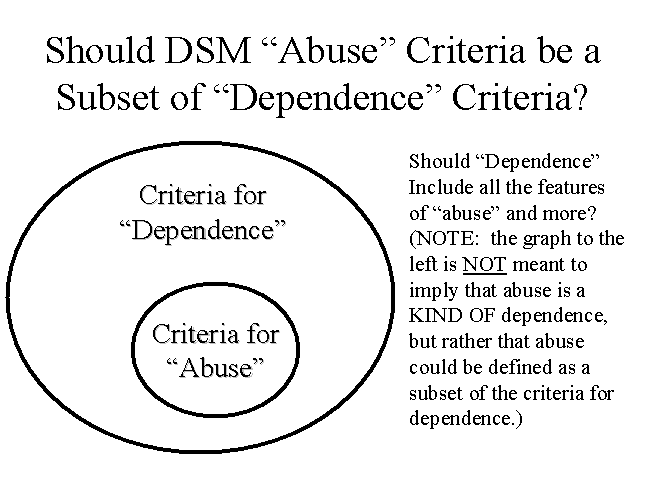
Malpractice Liability Could Result from Misunderstandings
Caused by DSM-IV-TR’s Use of the Word, “Dependence.?/u>
The
Following Recent Landmark Cases Involving Inadequate Treatment of Pain Exemplify
this Possibility.
(The comments below are by L. Jean Dunegan, MD, JD and are quoted from an interview by Pain.com)
Case 1
“We have seen
consequences for less than adequate pain management, not only from a licensure
standpoint but also from liability in state courts.
In 1999, as a result of an investigation of a physician’s
treatment as regards pain, from 1993 to 1998, the Oregon Board of Medical
Examiners sanctioned the physician’s license for one year for failing to
adequately assess and manage his patients' pain. Dr. Paul Bilder is a
55-year-old board-certified pulmonologist with a more than 20 year practice in
Oregon. The investigation of his patient care showed that in more than 5 cases
he refuses to use opioids appropriately (e.g. for patients on ventilators he
administered only paralytic agents, no pain medication or sedatives; to treat
air hunger for patients in the terminal phases of life he suggested only OTC
medications; for a patient with pulmonary insufficiency who needed emergency
intubation nasotracheally he used neither pain nor anti-anxiety medications.
To the charge that the Oregon Board was using Dr. Bilder as a scapegoat,
since Oregon is the only state that has allowed physician-assisted suicide
(PAS), the licensing board chair, Dr. George Porter, commented that 9 of the 11
board members are physicians. He emphasized that the decision to sanction Dr.
Bilder’s license was not made by the lay public but rather by physicians
judging their own peer. Dr. Porter also commented that under Oregon’s 1995
IPTA (Intractable Pain Treatment Act), if any patient in Oregon has a physician
who won’t take pain seriously, the patient has a right to have his records
transferred to another physician who will take pain seriously. This was a
landmark case as it was the first time a physician’s license was sanctioned
for failing to adequately assess and manage pain.?o:p>
Case 2
“A
recent civil negligence case in California illustrates what I believe will
become a trend in liability for substandard pain management:
Mr. William Bergman was an 87 year old male who died of metastatic lung
cancer and after death his adult children got together and complained that for
at least six months prior to Mr. Bergman’s death he suffered moderate to
severe pain that went largely unrelieved. His children decided that, in order to
make palliative care better for those to come after their father, they would ask
the licensing board of California to investigate the assessment and treatment of
Mr. Bergman’s pain by his physician, Dr. Chin. It was the family’s opinion
that their pleas for better pain management went unanswered. The licensing board
agreed to investigate and several months later they sent a letter to the
children stating that they (the board) were in agreement that Mr. Bergman’s
pain was inadequately controlled but they declined to take any action
against Dr. Chin as they did not find that he had violated the medical practice
act of California.
At that point the adult children decided to seek remedy in court as,
although they had not been seeking monetary compensation, neither did they even
get acknowledgment from Dr. Chin that his management of their father’s pain
was less than standard. They more or less decided that up to that point they
“didn’t get anywhere?and would have to sue in the court system for any
remedy. They were able to find an attorney, who happened to be the CEO of a
group in California called Dignity in Death, who filed the case against Dr. Chin
in the Superior Court of California. The reasons the case was not filed under
medical malpractice included: (1) the cap on pain and suffering ($250,000) for
medical malpractice cases in California; (2) in California medical malpractice
cases the pain and suffering is said to have died with the patient -- it does
not pass on to family for purposes of a law suit; and (3) in medical malpractice
cases in California, if the patient is victorious, he cannot collect punitive
damages or attorney’s fees. By filing instead under civil negligence/elder
abuse, these three barriers were lifted for the case of the plaintiffs (Mr.
Bergman’s children.)
As this case played out many physicians with whom I discussed the case
became irate that one could, in retrospect, zero in on Dr. Chin, citing patient
responsibility (i.e. Mr. Bergman had an obligation to fire one physician and
find another if he didn’t like the pain treatment he was receiving). My
response to this reaction involved my feeling that perhaps a patient’s
willingness to stand up for his rights depend on one’s generation. My father
died when he was 83. He worshipped the ground his physician walked upon, he had
the same physician most of his adult life, and I don’t believe it would even
have occurred to him to confront “Doc Joe?about less than adequate
treatment. My father began with the premise that “Whatever Doc Joe does for me
is good enough!?Perhaps Mr. Bergman was very much like my dad, unwilling to
confront the physician whom he deemed to be doing as good a job (in managing
pain) as possible. The jury's verdict reached in July of 2001 was against the
physician for $1.5 million.
This case is profound as it sends a loud message that there is a
liability in a retrospective fashion if one’s relationship with a patient and
his family does not show by documentation that pain was optimally assessed and
controlled. When we communicate with a patient and his family about his medical
condition we need to communicate about his disease(s) (e.g. the infection, the
blood pressure, the progress in rehab, the surgical wound, etc.) but also about
his signs and symptoms (e.g. how is he resting, is he in pain, is the pain
better controlled or the same, etc.)
Mandatory evaluation and charting of pain will, as of 1-1-01 via
JCAHO’s guidelines, facilitate establishing that, in a specific case, the pain
care provided was inadequate and that professional discipline is indicated if a
similar substandard pattern is established.
Risk management departments in many large hospitals are even now
beginning to acknowledge that inadequate concern and actions in under-treated
pain is a risk for any health care facility and this will lead to more
aggressive pain care.
Final Comment
I
conclude from my data that, overall, less harm would result if we use the word,
“addiction,?for the syndrome that the DSM-IV-TR now calls,
“dependence. While not everyone agrees with this conclusion, my survey
data strongly suggest the need to re-open this debate.
For inquiries regarding this article or for permission to re-print all or a portion of this article, contact John Tennison, MD at tennison@texaspsychiatry.net, call 210-884-0990, or write to: John Tennison, MD, PO Box 40172, San Antonio, TX 78229. John Tennison is a psychiatrist who practices in San Antonio, TX. Seefor more details.